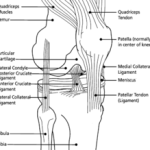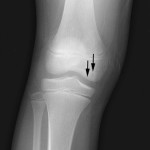Introduction
Patellofemoral pain syndrome (PFPS) is a condition that sports physiotherapists rehabilitate on a common basis. The prevalence of the condition is higher in women, and in an athletic population. Therefore, it is essential that sports physiotherapists are aware of the most effective interventions for this condition.
Traditionally, the main-stays of treatment have been solely aimed at the patellar. These include hamstring, gastrocnemius and ilio-tibial band (ITB) stretching, quadricep (VMO) strengthening and patellar McConnel taping. Whilst these treatments are effective components of the rehabilitation program, recent research has suggested the sports physiotherapist should assess other components of the lower limb kinetic chain.
The Role of Pelvic Stability
Recent studies have shown that females with patellofemoral pain syndrome have:
- Increased femoral internal rotation during WB activities (Powers et al, 2003)
- Increased adduction and internal hip rotation causing a dynamic valgus alignment (Souza et al, 2009)
- Weakness of the hip abductors and external rotators (Bolgla et al, 2003)
However, despite these findings there has until recently been limited evidence of the effectiveness of strengthening the pelvic musculature in these populations.
The New Research Review
TITLE: Short-Term Effects of Hip Abductors and Lateral Rotators Strengthening in Females With Patellofemoral Pain Syndrome: A Randomized Controlled Clinical Trial
AUTHORS: Fukuda, TY, Rossetto FM, Magalhães E, Bryk FF, Lucareli PRG, Carvalho NA.
REFERENCE: J Orthop Sports Phys Ther 2010;40(11):736-742
METHODS: Seventy females diagnosed with patellofemoral pain syndrome were randomised into 3 groups:
- Knee Exercise Group (KE)
- Knee and Hip Exercise Group (KHE)
- Control Group (CO)
NB: It is important to note that the study population was not athletic.
Interventions
The exercise groups performed a supervised exercise program 3 sessions a week for the 4 week period.
- The KE group performed 3 x 30 second stretches of the hamstrings, quadriceps, gastrocnemius and ITB. They also performed seated knee extensions (90-45), leg press (0-45), squat (0-45), and NWB iliopsoas strengthening.
- The KHE group performed the knee exercises as above. They added standing resisted hip abduction, sidelying resisted hip abduction, side stepping with theraband, and seated resisted hip external rotation.
Examples of Exercises
Results
At the 4 week evaluation both the KE and the KHE group showed statistically significant improvements on the Lower Extremity Functional Score (LEFS), Anter ior Knee Pain Scale (AKPS), and the single leg single hop test. However, there was no significant difference between the two groups.
The KHE group, however, showed a greater reduction in the 11-Point Numerical Pain Rating Scale (NPRS) on descending stairs. The KHE group’s improvements were above the minimal clinically important difference (MCID) for the LEFS, AKPS and NPRS.
Limitations of This New Research
- The study population is sedentary, which means the validity for use in an athletic population is questionable.
- Strength is not used as an outcome assessment. Therefore, it cannot be assumed that improvement where related to an increase in strength. Given the short term nature of the study, it is possible that the improvements shown were related to neuromuscular adaptations.
- There is no long-term follow-up
Clinical Implications of This New Research
This research suggests that the addition of hip external rotator and abductor strengthening to a program of knee strengthening and stretching leads to improved outcomes in females with patellofemoral pain syndrome. However, you must always consider the limitations discussed above.
Whilst the optimal exercise prescription is not assessed, the program described above of 3 times weekly utilising 3 sets of 10 repetitions at a resistance of 70% 1 repetition maximum seems to be effective.
Conclusions
This new research may not dramatically change the clinical practice of many sports physiotherapists out there, as I’m sure many are already utilising pelvic strengthening as a component of PFPS treatment. If you are in this group, it is comforting to know that we are operating with the support of clinical research. It is also interesting to note that effects of such an exercise program can produce clinically important changes in such a short time frame.
What are you thoughts on the use of pelvic strengthening exercises in patients with patellofemoral pain? Do you find it clinically effective? Comment here or catch me on Twitter or Facebook.
References
Bolgla LA, Malone TR, Umberger BR, Uhl TL. Hip strength and hip and knee kinematics during stair descent in females with and without patellofemoral pain syndrome. J Orthop Sports Phys Ther. 2008;38:12-18.
Powers CM, Ward SR, Fredericson M, Guillet M, Shellock FG. Patellofemoral kinematics during weight-bearing and non-weight-bearing knee extension in persons with lateral subluxation of the patella: a preliminary study. J Orthop Sports Phys Ther. 2003;33:677-685.
Souza RB, Powers CM. Differences in hip kinematics, muscle strength, and muscle activation between subjects with and without patellofemoral pain. J Orthop Sports Phys Ther. 2009;39:12- 19
Fukuda TY, Rossetto FM, Magalhães E, Bryk FF, Lucareli PRG, Carvalho NA. Short-Term Effects of Hip Abductors and Lateral Rotators Strengthening in Females With Patellofemoral Pain Syndrome: A Randomized Controlled Clinical Trial. J Orthop Sports Phys Ther 2010;40(11):736-742
Related Posts
Comments
Trackbacks
-
[…] for a few weeks. No strenuous activity and it should heal right upPowered by Yahoo! AnswersMary asks…Pls suggest me one of the best Doctor for knee sports injuries in N.C.R?Pls one of the b…ts injuries in N.C.R?Pls one of the best best bestadmin answers:Use Soma. It really helps.Robert […]










this post is very usefull thx!